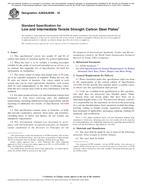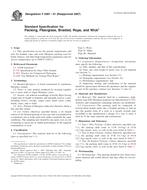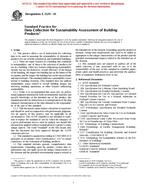Click here to purchase
These test methods cover laboratory compaction methods used to determine the relationship between molding water content and dry unit weight of soils (compaction curve) compacted in a 4 or 6-in. (101.6 or 152.4-mm) diameter mold with a 5.50-lbf (24.5-N) rammer dropped from a height of 12.0 in. (305 mm) producing a compactive effort of 12 400 ft-lbf/ft³ (600 kN-m/m³).
Note 1 – The equipment and procedures are similar as those proposed by R. R. Proctor – Engineering News Record, September 7, 1933) with this one major exception: his rammer blows were applied as “12 inch firm strokes“ instead of free fall, producing variable compactive effort depending on the operator, but probably in the range 15 000 to 25 000 ft-lbf/ft³ (700 to 1200 kN-m/m³). The standard effort test (see 3.1.4) is sometimes referred to as the Proctor Test.
Soils and soil-aggregate mixtures are to be regarded as natural occurring fine- or coarse-grained soils, or composites or mixtures of natural soils, or mixtures of natural and processed soils or aggregates such as gravel or crushed rock. Hereafter referred to as either soil or material.
1.2 These test methods apply only to soils (materials) that have 30 % or less by mass of particles retained on the ¾-in. (19.0-mm) sieve and have not been previously compacted in the laboratory; that is, do not reuse compacted soil.
1.2.1 For relationships between unit weights and molding water contents of soils with 30 % or less by mass of material retained on the ¾ -in. (19.0-mm) sieve to unit weights and molding water contents of the fraction passing ¾ -in. (19.0-mm) sieve, see Practice D4718.
1.3 Three alternative methods are provided. The method used shall be as indicated in the specification for the material being tested. If no method is specified, the choice should be based on the material gradation.
1.3.1 Method A:
1.3.1.1 Mold – 4-in. (101.6-mm) diameter.
1.3.1.2 Material – Passing No. 4 (4.75-mm) sieve.
1.3.1.3 Layers – Three.
1.3.1.4 Blows per Layer – 25.
1.3.1.5 Usage – May be used if 25 % or less (see Section 1.4 ) by mass of the material is retained on the No. 4 (4.75-mm) sieve.
1.3.1.6 Other Usage – If this gradation requirement cannot be met, then Method C may be used.
1.3.2 Method B:
1.3.2.1 Mold – 4-in. (101.6-mm) diameter.
1.3.2.2 Material – Passing ³/8-in. (9.5-mm) sieve.
1.3.2.3 Layers – Three.
1.3.2.4 Blows per Layer – 25.
1.3.2.5 Usage – May be used if 25 % or less (see Section 1.4 ) by mass of the material is retained on the ³/8-in. (9.5-mm) sieve.
1.3.2.6 Other Usage – If this gradation requirement cannot be met, then Method C may be used.
1.3.3 Method C:
1.3.3.1 Mold – 6-in. (152.4-mm) diameter.
1.3.3.2 Material – Passing ¾-in. (19.0-mm) sieve.
1.3.3.3 Layers – Three.
1.3.3.4 Blows per Layer – 56.
1.3.3.5 Usage – May be used if 30 % or less (see Section 1.4 ) by mass of the material is retained on the ¾-in. (19.0-mm) sieve.
1.3.4 The 6-in. (152.4-mm) diameter mold shall not be used with Method A or B.
Note 2 – Results have been found to vary slightly when a material is tested at the same compactive effort in different size molds, with the smaller mold size typically yielding larger values of density/unit weight (1, pp. 21+).
Product Details
- Published:
- 05/01/2012
- Number of Pages:
- 13
- File Size:
- 1 file , 260 KB
- Redline File Size:
- 2 files , 350 KB


